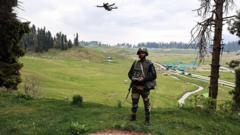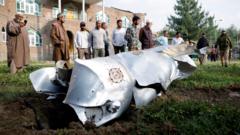As tensions rise, both nations engage in a dangerous exchange of unmanned aerial assaults.
**New Era of Conflict: The Drone War between India and Pakistan Unfolds**

**New Era of Conflict: The Drone War between India and Pakistan Unfolds**
A historic escalation in the India-Pakistan rivalry sees drone warfare redefine tactics and strategies.
Recent developments in South Asia signal a remarkable shift in the long-standing conflict between India and Pakistan, introducing the world to its first drone war between two nuclear-armed states. On Thursday, India accused Pakistan of initiating aggressive drone and missile strikes on multiple military installations within Indian territory, particularly in Kashmir, which Pakistan has categorically denied.
In their response, Pakistan claimed to have intercepted and shot down 25 Indian drones over several urban centers, including its major cities of Karachi, Lahore, and Rawalpindi. This exchange of unmanned aerial assaults has sparked concerns among global powers, with many urging both nations for restraint amidst fears of further escalation in the nuclear-volatile region. "The advent of drone warfare signifies a new era, where unmanned precision may dictate either escalation or restraint," noted Jahara Matisek from the US Naval War College.
Reports indicate that cross-border skirmishes have already resulted in significant casualties. India claims its recent bombardment was retribution for a deadly militant attack in Pahalgam, which Pakistan rejects, while civilians on both sides have suffered losses — a tragic consequence in an ever-evolving military theater. With the use of drones now a pivotal aspect of military tactics, experts highlight their dual roles in both reconnaissance and direct attacks, reshaping engagement protocols.
India's fleet, primarily based on Israeli technology, includes advanced reconnaissance drones capable of long endurance and precision strikes, while Pakistan has developed an extensive array of both indigenous and imported UAVs, including support from Turkey and China. The rise of drone capabilities for both countries could potentially shift the balance of power in the region, although currently many experts view it as a symbolic evolution rather than a true paradigm shift.
While drone warfare may represent a less aggressive approach compared to traditional manned aircraft strikes, analysts warn that this could be a precursor to more substantial military actions. The frequent exchanges illustrate an ongoing tactical reaction rather than a full-fledged war strategy. As both nations evaluate their drone capabilities and responses to aerial provocations, concerns emerge over the unpredictable dynamics this new conflict introduces into the fraught relationship between these nuclear neighbors.
The use of drones opens discussions about the political consequences of lowered military thresholds and the risks of escalation with each engagement. With both countries at a watershed moment in their military evolution, the stakes have never been higher in terms of potential consequences for regional stability.
In their response, Pakistan claimed to have intercepted and shot down 25 Indian drones over several urban centers, including its major cities of Karachi, Lahore, and Rawalpindi. This exchange of unmanned aerial assaults has sparked concerns among global powers, with many urging both nations for restraint amidst fears of further escalation in the nuclear-volatile region. "The advent of drone warfare signifies a new era, where unmanned precision may dictate either escalation or restraint," noted Jahara Matisek from the US Naval War College.
Reports indicate that cross-border skirmishes have already resulted in significant casualties. India claims its recent bombardment was retribution for a deadly militant attack in Pahalgam, which Pakistan rejects, while civilians on both sides have suffered losses — a tragic consequence in an ever-evolving military theater. With the use of drones now a pivotal aspect of military tactics, experts highlight their dual roles in both reconnaissance and direct attacks, reshaping engagement protocols.
India's fleet, primarily based on Israeli technology, includes advanced reconnaissance drones capable of long endurance and precision strikes, while Pakistan has developed an extensive array of both indigenous and imported UAVs, including support from Turkey and China. The rise of drone capabilities for both countries could potentially shift the balance of power in the region, although currently many experts view it as a symbolic evolution rather than a true paradigm shift.
While drone warfare may represent a less aggressive approach compared to traditional manned aircraft strikes, analysts warn that this could be a precursor to more substantial military actions. The frequent exchanges illustrate an ongoing tactical reaction rather than a full-fledged war strategy. As both nations evaluate their drone capabilities and responses to aerial provocations, concerns emerge over the unpredictable dynamics this new conflict introduces into the fraught relationship between these nuclear neighbors.
The use of drones opens discussions about the political consequences of lowered military thresholds and the risks of escalation with each engagement. With both countries at a watershed moment in their military evolution, the stakes have never been higher in terms of potential consequences for regional stability.

















